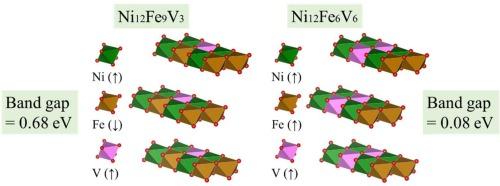通过V掺杂调节NiFe层状双氢氧化物的带隙:第一性原理研究
IF 6.1
2区 材料科学
Q1 MATERIALS SCIENCE, COATINGS & FILMS
引用次数: 0
摘要
利用第一性原理计算,我们探讨了阳离子有序、磁态和掺杂浓度对NiFe和NiFeV层状双氢氧化物(LDHs)带隙的影响。我们的研究结果表明,在特定的结构约束下,这些成分可以调节带隙,从1.73 (Ni:Fe = 3:1)缩小到0.75 eV (Ni:Fe = 5:3),从1.71 (Ni:Fe:V = 6:1:1)缩小到0.68 (Ni:Fe:V = 4:3:1),进一步降低到0.08 eV (Ni:Fe:V = 2:1:1)。这种带隙控制源于铁离子氧化态的变化。我们的研究结果揭示了最低带隙下NiFeV LDHs的最佳配置,为设计高效光电器件和OER催化剂提供了见解。本文章由计算机程序翻译,如有差异,请以英文原文为准。

Tuning bandgaps of NiFe layered double hydroxides through V doping: A first-principles study
Using first-principles calculations, we explore the effects of cation ordering, magnetic states, and doping concentrations on bandgaps of NiFe and NiFeV layered double hydroxides (LDHs). Our results indicate that the compositions modulate the bandgaps, narrowed from 1.73 (Ni:Fe = 3:1) to 0.75 eV (Ni:Fe = 5:3), as well as from 1.71 (Ni:Fe:V = 6:1:1) to 0.68 (Ni:Fe:V = 4:3:1), and further downs to 0.08 eV (Ni:Fe:V = 2:1:1) under specific structural constraints. This bandgap control originates from changes in the oxidation states of Fe ions. Our results reveal the optimal configuration of NiFeV LDHs for the lowest bandgap, providing insights for designing efficient optoelectronic devices and OER catalysts.
求助全文
通过发布文献求助,成功后即可免费获取论文全文。
去求助
来源期刊

Surface & Coatings Technology
工程技术-材料科学:膜
CiteScore
10.00
自引率
11.10%
发文量
921
审稿时长
19 days
期刊介绍:
Surface and Coatings Technology is an international archival journal publishing scientific papers on significant developments in surface and interface engineering to modify and improve the surface properties of materials for protection in demanding contact conditions or aggressive environments, or for enhanced functional performance. Contributions range from original scientific articles concerned with fundamental and applied aspects of research or direct applications of metallic, inorganic, organic and composite coatings, to invited reviews of current technology in specific areas. Papers submitted to this journal are expected to be in line with the following aspects in processes, and properties/performance:
A. Processes: Physical and chemical vapour deposition techniques, thermal and plasma spraying, surface modification by directed energy techniques such as ion, electron and laser beams, thermo-chemical treatment, wet chemical and electrochemical processes such as plating, sol-gel coating, anodization, plasma electrolytic oxidation, etc., but excluding painting.
B. Properties/performance: friction performance, wear resistance (e.g., abrasion, erosion, fretting, etc), corrosion and oxidation resistance, thermal protection, diffusion resistance, hydrophilicity/hydrophobicity, and properties relevant to smart materials behaviour and enhanced multifunctional performance for environmental, energy and medical applications, but excluding device aspects.
 求助内容:
求助内容: 应助结果提醒方式:
应助结果提醒方式:


